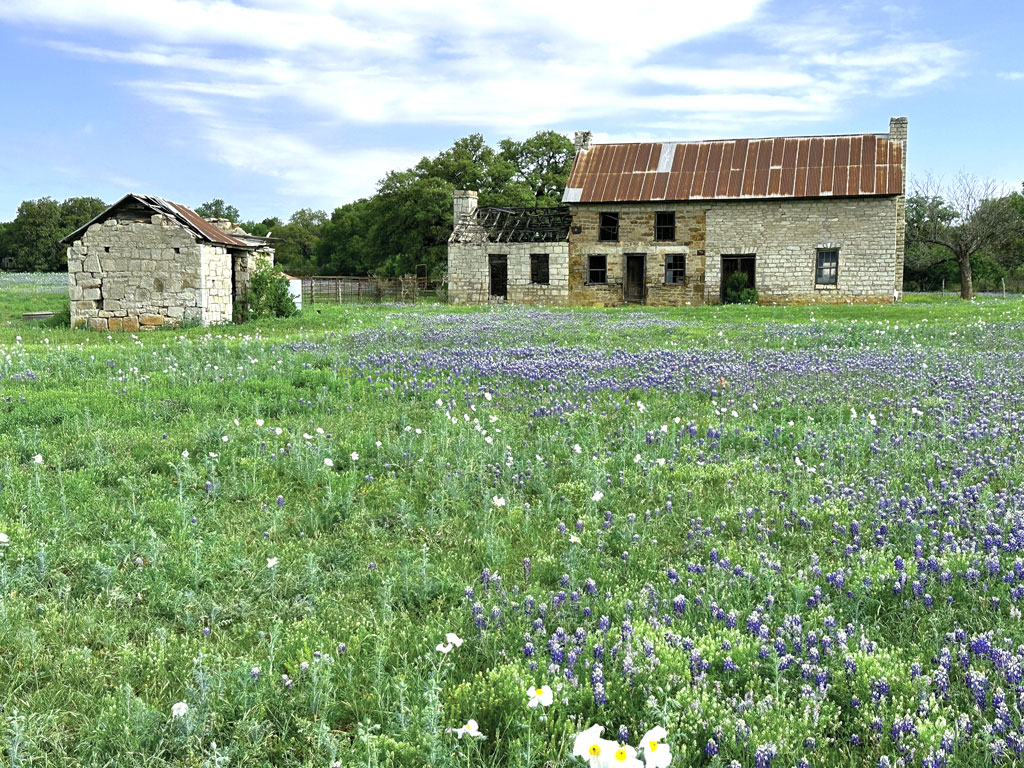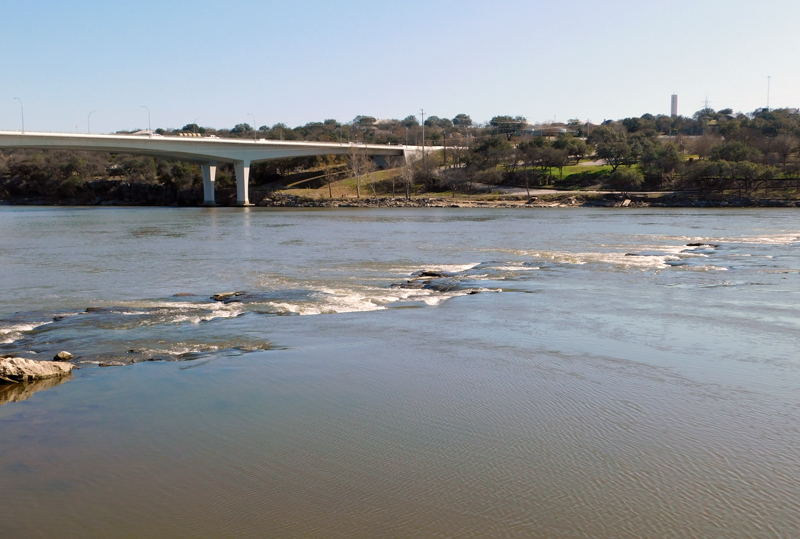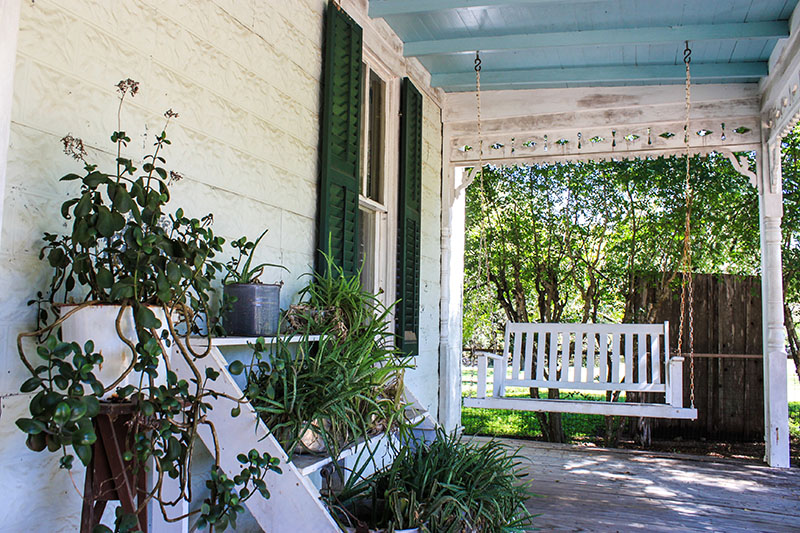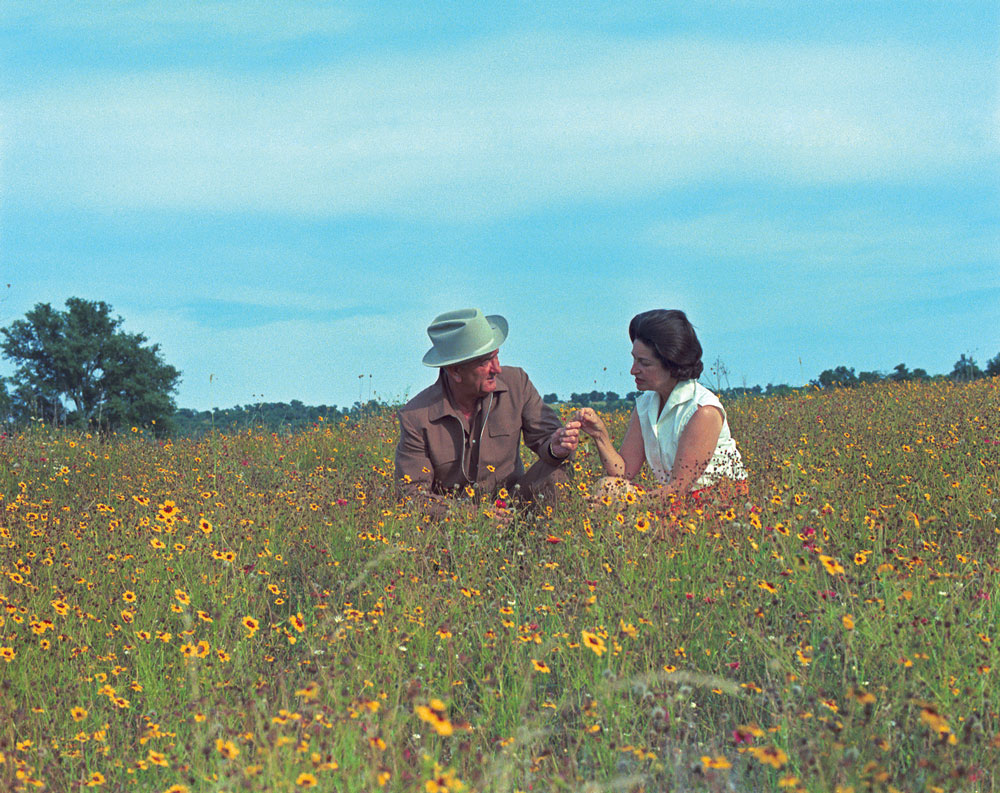
The Bluebonnet House in late March 2023, surrounded by bluebonnets. The Marble Falls structure is famous worldwide for its rich Texas history, architectural style, and iconic Hill Country landscape, especially during wildflower season. Staff photo by Suzanne Freeman
When spring wildflowers bloom along U.S. 281 in north Marble Falls, they highlight one of Burnet County’s historical gems: the “Bluebonnet House,” built in 1853.
“It’s such an icon,” said Burnet resident Tommye Potts, whose grandfather Christian Dorbandt Jr. was born in the house in 1857. “This house is known worldwide. I’ve seen pictures of it on everything. I’ve even seen a shower curtain with this house on it.”
In late March and early April, a vibrant field of bluebonnets separates the stone house and barn from the highway. The acreage is surrounded by a barbed-wire fence where spectators line up to take photos at the turnoff to the Pedernales Electric Cooperative district office.
The Bluebonnet House is on Preservation Texas’ most endangered places list and is eligible for the National Register of Historic Places. The Burnet Central Appraisal District records the owner as Gladys Atkinson Management Trust. Atkinson, who purchased the house in 1976, died in 2019.
The Dorbandts were the second family to own the property by deed, which included 212 acres, but no one is quite sure who built the house or, at least, the original part in the center. Two additions were tacked on over the years.
One school of thought is that Logan Vandeveer built the center section on land granted to him by the newly formed Republic of Texas to use as his ranch headquarters. His family of four daughters lived in Burnet so they could more easily attend school. His wife died sometime around 1850, but no gravesite or record of her death has been found, according to the Texas State Historical Association.
More than 2,000 acres of land, including the property where the Bluebonnet House now stands, was given to Vandeveer as a soldier in the Texas Revolution. He was wounded at the Battle of San Jacinto, where Texas won its independence from Mexico. Many, including Potts, believe the house was built by Christian Dorbandt Sr., her great-grandfather, who was stationed with the U.S. Army 2nd Regiment of Light Dragoons at Fort Croghan in Burnet. A native of Denmark, he and his Irish wife, Annie Dunlavy, are believed to be the first family to call the house home.
“As I grew up, all my family has always said that Capt. Dorbandt built that house,” Potts said.
Three of Christian and Annie’s 14 children were born in the Bluebonnet House, including Potts’ grandfather Christian Jr. Their first child, Henrietta, was the first white woman born in Burnet County, just two months after the first white man, George Holland, according to records. Holland was born in October 1853; Henrietta in December of that year.
According to Potts’ aunt Rethie Dorbandt, the house was built with slave labor.
“At the time, there was a black stonemason named Primus Lewis,” Potts said. “He built the chimneys, and she thinks it’s likely he built the house, too.”
The Dorbandts moved into the house in 1853, the year it was built. Records show that Vandeveer sold 212 acres, including the house, to Dorbandt and Theodore Winkle, another soldier at Fort Croghan, in February 1855. Potts has a copy of the recorded, handwritten deed with Vandeveer’s signature. A second recorded copy has “Satisfied deed” written across it.
Soon after selling the property, Vandeveer and his brother Zachery set off on a cattle drive to Louisiana, where he counted on selling enough beef cows to pay off a $6,000 debt he owed Fort Croghan’s last commander, 1st Lt. Newton C. Givens. Vandeveer made his living selling beef to the fort. When it closed, he had to find a new source of income, which is why he and Zachery hit the cattle trail to New Orleans.
By September 1855, the brothers were dead, victims of Yellow Fever. Logan was 40 years old; Zachery 36.
Vandeveer had no will and left behind four orphaned daughters ages 16, 14, 9, and 6, who were now in debt and homeless.
“(The daughters) wanted the land and the house,” Potts said. “What I think is that my great-grandfather walked away from it. He was an honorable man and always said he was proud that he and his children had never done anything to end up in court. The daughters were orphans. Everything was tied up in court. Rather than go to court, he just walked away.”
Eliza and her sisters moved into what was then known as the Dorbandt House. Eliza married John Randolph Hubbard in 1856 when she was 17. He was the nephew of another local historical figure of note, Noah Smithwick.
Like Smithwick, Hubbard was a known supporter of the Union during the Civil War (1861-65). Smithwick had already left for the safety of California when Hubbard decided to leave the area, too. He didn’t get far. He was ambushed by bushwhackers in 1863 at the height of the war. His body was thrown into what is to this day known as Hubbard Falls on Cow Creek northeast of Smithwick.
In 1869, Eliza exchanged houses with her sister Emily Christian. Only three years later, Emily sold it to N.A. Cavin, passing the house out of the Vandeveer family’s hands for good. Cavin is believed to have built the eastern addition.
In 1889, Cavin sold the home to Fielding Harper Holloway, an entrepreneur who put up the first telephone and telegraph lines between Lampasas, Burnet, Marble Falls, and Austin. He was instrumental in bringing the railroad to the area and also built the state’s first tannery and boot factory in Marble Falls.
The next owner was rancher Ernest Herman Odiorne. He bought the property in 1905. He died 11 years later from an accidental self-inflicted gunshot wound while crawling through a barbed-wire fence. Before his death, he sold the property to his brother James Eben Odiorne. That was in 1908.
In 1911, Odiorne sold to Charles F. Konvicka, who was a native of Austria. He and his wife, Anna Mican Konvicka, also an Austrian native, had 10 children.
Two of those children, Anton and Angeline, were living in the house when Potts first visited it with her mother at the age of 11. The Konvicka siblings were the last family to ever live there.
“I was just amazed at it,” Potts said of her visit in 1960. “Those people lived very simply. They had a table and chair and two beds in the main room by the fireplace. I remember there was a package of cereal, just dried cereal and canned milk on that table. They were very nice to me and welcomed us in.”
Legend has it that Charles Konvicka built a car inside the house and then couldn’t get it out. Potts said she saw no car on the property, but according to a 2020 magazine article, a relative said Charles bought a car but couldn’t drive. He never registered the vehicle, so his sons removed the tires and put the car on blocks in the barn.
Angeline died in 1973; Anton in 1975. A year later, the house went to the Atkinson family in an estate sale.
Potts returned to the house in 2013 with the Burnet County Historical Commission for a tour.
“We saw then it was deteriorating,” she said. “It was full of old appliances and garbage.”
Members of the Burnet County Historical Commission hope to someday have a subject marker placed on Texas Department of Transportation property along U.S. 281 near the house.
“We deal with history and historical buildings, and we’d like to honor it,” commission Chair Rachel Bryson said in 2023. “The Bluebonnet House has been in Texas Monthly; it’s been all over the place. The commission hopes to someday have a marker near there to explain the history of the house and give it the recognition it deserves.”
Good luck putting all this history (because it’s not nearly everything) on a 27-inch-by-42-inch marker!












